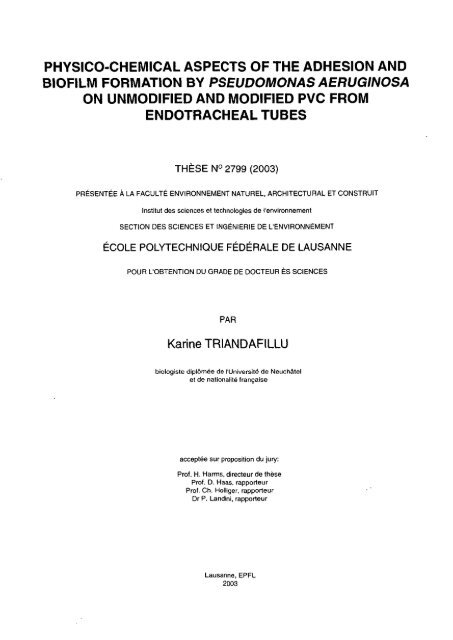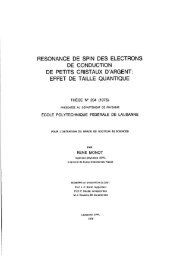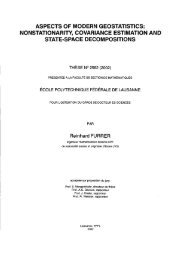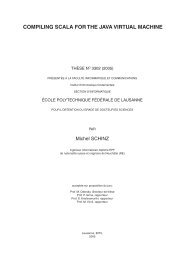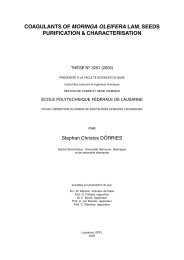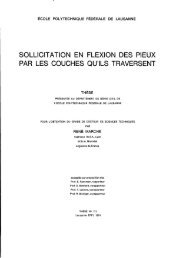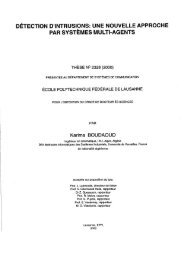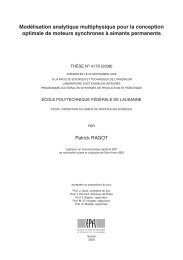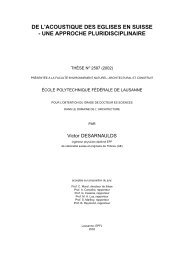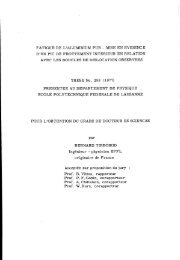PHYSICO-CHEMICAL ASPECTS OF THE ADHESION AND ... - EPFL
PHYSICO-CHEMICAL ASPECTS OF THE ADHESION AND ... - EPFL
PHYSICO-CHEMICAL ASPECTS OF THE ADHESION AND ... - EPFL
You also want an ePaper? Increase the reach of your titles
YUMPU automatically turns print PDFs into web optimized ePapers that Google loves.
<strong>PHYSICO</strong>-<strong>CHEMICAL</strong> <strong>ASPECTS</strong> <strong>OF</strong> <strong>THE</strong> <strong>ADHESION</strong> <strong>AND</strong><br />
Bl<strong>OF</strong>lLM FORMATION BY PSEUDOMONAS AERUGINOSA<br />
ON UNMODlFlED <strong>AND</strong> MODlFlED PVC FROM<br />
ENDOTRACHEAL TUBES<br />
PRÉSENTÉE A LA FACULTÉ ENVIRONNEMENT NATUREL, ARCHITECTURAL ET CONSTRUIT<br />
Institut des sciences et technologies de l'environnement<br />
SECTION DES SCIENCES ET INGÉNIERIE DE L'ENVIRONNEMENT<br />
ÉCOLE POLYTECHNIQUE FÉDÉRALE DE LAUSANNE<br />
POUR L'OBTENTION DU GRADE DE DOCTEUR ÈS SCIENCES<br />
PAR<br />
Karine TRI<strong>AND</strong>AFILLU<br />
biologiste diplornée de l'université de Neuchâtel<br />
et de nationalité française<br />
acceptée sur proposition du juiy:<br />
Prof. H. Harms, directeur de thèse<br />
Prof. D. Haas. rapporteur<br />
Prof. Ch. Holliger. rapporteur<br />
Dr P. Landini, rapporteur<br />
Lausanne, <strong>EPFL</strong><br />
2003
SUMMARY<br />
Nosocornial (hospital acquired) pneumonia is a major medical complication in intubated<br />
and mechanically ventilated patients. The bacterium Pseudomonns aerugir~osa is one of the<br />
most prevalent nosocomial pathogen, responsible for 30 % of nosocomial infections, of which<br />
47 % are ventilator-associated pneumonia (VAP). Prolonged intubation with an endotracheal<br />
device is a major risk factor for VAP, where colonization of the upper respiratory tract by<br />
P. neruginosa occurs in 90 % of patients, with a mortality reaching 40 % despite aggressive<br />
antibiotic therapy. Therefore, a new strategy to prevent or at least to delay the occurrence of<br />
VAP due to P. neruginosa is desirable. Successful bacterial colonization of the upper<br />
respiratory tract involves the formation of biofilms on the surface of the intubation devices.<br />
As it is generally accepted that biofilm formation is initiated by the crucial event of adhesion<br />
of bacteria to a solid support. we investigated in this dissertation whether bacterial adhesion<br />
could be reduced by surface modification of the polymer commonly used in endotracheal<br />
devices, medical grade poly(viny1 chloride ) (PVC).<br />
Initial bacterial adhesion can be considered for the most part in terms of colloidal<br />
interaction forces goveined by physicochemical properties of the bacteria, the substratum<br />
surface and the surrounding environment, as described in the extended DLVO theory.<br />
Deviations from theory-based predictions arise from the fact that bacteria are not smooth<br />
colloidal particles, but possess surface structural features like pili, flagella and<br />
lipopolysaccharides (LPS), that may favour the subsequent molecular and irreversible<br />
attachment of bacteria to a solid surface. Attempts to prevent the attachment of pathogens to<br />
the endotracheal tubes first require a better insight of the biomaterial and bacteriai properties<br />
involved in this process. The surface characteristics of a biomaterial can affect the affinity of<br />
the bacteria for the polymer. In order to change the substrate accordingly, some<br />
physicochemical properties of the bacteria must be known. We tested a wide range of P.<br />
neruginosa strains, including the wildtype PAOI. specific mutants and clinical isolates from<br />
tracheal secretions or the blood of patients presenting a VAP. It was demonstrated that the<br />
surface of most P. aeruginosa strains was hydrophobic and negatively charged. Their overall<br />
adhesion efficiency to untreated PVC pieces varied widely, which could be partly explained<br />
by structural peculiarities of the surfaces of the strains. Generally, hydrophobic bacteria<br />
adhere more than hydrophilic bacteria, and preferentially on hydrophobic supports.
Incidentally, several physicochemical surface modifications of the PVC substrate were<br />
evaluated by in vitro assays for their potential to make the polyrner less attractive to bacteria.<br />
The newly obtained biomaterials were characterized for their surface chernical composition,<br />
wettability and roughness as parameters known to influence bacterial adhesion. First, an<br />
oxygen plasma treatment yielding a hydrophilic surface was effective in reducing bacterial<br />
adhesion by 70% as compared to native PVC. Secondly, the deposition of anti-microbial<br />
silver ions as salt clusters on the PVC surface completely prevented the initial bacterial<br />
adhesion due to specific bacterial toxic effects of silver. PEO (polyethylene oxide)-like<br />
coatings and physisorption of ~luronics@ created non-fouling (protein resistant) surfaces but<br />
did not affect P. aeruginosa adhesion.<br />
Following the adhesion process, bacteria can proliferate to form mature, multi-layer<br />
biofilms on colonized surfaces. Thus, the creation of anti-adhesive surfaces may not<br />
necessarily lead to biofilm-resistant surfaces. The long-tem efficacy of the two most<br />
prornising surface modifications, i.e. oxygen-plasma treated and silver-coated PVC, to reduce<br />
or prevent biofilm development by P. aerugirzosa strains was therefore tested in a continuous<br />
flow cultivation system. It was concluded that an observed significant reduction of bacterial<br />
adhesion after hydrophilization of PVC was not sufficient to inhibit the formation of biofilm<br />
on the intubation device. In contrast, the anti-rnicrobial properties of silver allowed to delay<br />
the biofilm development on the biomaterial, but due to the progressive dissolution of the<br />
silver deposits into the bulk medium, bacteria became able to adhere and proliferate on the<br />
surface after a few hours. These experiments indicate the great potential of silver as an anti-<br />
biofilm agent but at the same time illustrate the need to develop new surface treatment<br />
methods in order to produce longer-lasting silver deposits on PVC surfaces.
III<br />
VERSION ABBREGEE<br />
Les pneumonies nosocomiales (acquises à l'hôpital) se sont révélées une complication<br />
médicale majeure chez les patients intubés et ventilés mécaniquement. Pseudornoi~as<br />
nen~gir~osn est un des plus important pathogènes bactériens présent en milieu hospitalier,<br />
responsable de 30 % des infections, dont 47% sont des pneumonies "ventilatoires" (ventilator-<br />
associated pneumonia, VAP). L'intubation prolongée avec un instrument endotrachéal<br />
entraîne de grands risques de développer une VAP, puisqu'une colonisation du tractus<br />
respiratoire supérieur par P. aeruginosa apparaît chez 90% des patients, avec une mortalité<br />
atteignant 40% malgré une forte thérapie antibiotique. Par conséquent, il est nécessaire de<br />
mettre au point une nouvelle stratégie permettant d'empêcher, ou du moins de réduire<br />
l'apparition de VAP dues à P. aeruginosa. La colonisation bactérienne du tractus respiratoire<br />
implique la formation de biofilms sur la surface du matériel d'intubation. Comme il est<br />
généralement admis que la formation de biofilrns est initiée par l'adhésion de bactéries sur un<br />
support solide, nous avons envisagé dans cette thèse que l'adhésion bactérienne puisse être<br />
réduite par une modification de surface du polymère communément utilisé pour les tubes<br />
endotrachéaux, le polychlorure de vinyl (PVC) de type médical.<br />
L'adhésion bactérienne initiale peut être partiellement considérée en termes d'interactions<br />
colloïdales gouvernées par les propriétés physico-chimiques de surface des bactéries, du<br />
support et du milieu environnant, comme décrit dans la théorie DLVO. Les résultats déviant<br />
des prédictions basées sur cette théorie sont dus au fait que les bactéries ne sont pas des<br />
particules colloïdales lisses, mais possèdent des traits structuraux de surfaces comme les pili,<br />
les flagelles et les lipopolysaccharides (LPS), qui peuvent favoriser l'attachement moléculaire<br />
irréversible des bactéries à une surface solide. Une tentative d'empêcher l'adhésion de<br />
pathogènes bactériens sur les tubes endotrachéaux nécessite d'abord une meilleure<br />
connaissance des propriétés du biomatériau et des bactéries impliquées dans ce processus. Les<br />
caractéristiques de surface d'un biomatériau peuvent affecter l'affinité des bactéries pour le<br />
biomatériau en question. Afin de changer le substrat en conséquence, certaines propriétés<br />
physico-chimiques des bactéries doivent aussi être déterminées. Nous avons testé un grand<br />
nombre de souches de P. aeruginosa, incluant le type sauvage PAO1, des mutants spécifiques<br />
et des isolats cliniques provenant de sécrétions trachéales ou du sang de patients présentant<br />
une VAP. il a été montré que la surface de la plupart des souches était hydrophobe et
négativement chargée. Leur efficacité d'adhésion sur des coupons de PVC non traités est<br />
apparue très variable, ce que nous avons tenté d'expliquer par certaines particularités<br />
structurales de surface de ces souches. Généralement, les bactéries hydrophobes adhèrent<br />
davantage que les bactéries hydrophiles, et préférentiellement sur des supports hydrophobes<br />
eux aussi. De ce fait, plusieurs modifications de surfaces des substrats PVC ont été testées in<br />
vitro afin d'évaluer leur potentiel de rendre le polymère moins attractif pour les bactéries. La<br />
composition chimique, I'hydophobicité et la rugosité de surface de ces "nouveaux"<br />
biomatériaux ont également été déterminées, puisque ce sont des paramètres reconnus pour<br />
influencer I'adhésion bactérienne. Tout d'abord, un traitement par plasma oxygène a produit<br />
une surface hydrophile réduisant I'adhésion des bactéries de 70% comparé au PVC natif.<br />
Deuxièmement, l'incorporation sous forme d'agglomérats d'ions argent sur le PVC a permis<br />
d'inhiber totalement I'adhésion bactérienne initiale grâce aux effets bactéricides de I'argent.<br />
Le dépôt de poly-oxyde d'éthylène (PEO) et la physisoiption de ~luronics@ ont créé des<br />
surfaces résistant à l'adsorption de protéines mais sans effet sur I'adhésion de P. neruginosa.<br />
Suite au processus d'adhésion, les bactéries peuvent proliférer pour former d'épais<br />
biofilms sur les surfaces colonisées. Ainsi, des surfaces anti-adhésives pour les bactéries ne<br />
seront pas forcément des surfaces égaiement résistantes au développement de biofilms.<br />
L'efficacité des deux modifications de surfaces les plus prometteuses (i.e. un PVC traité au<br />
plasma oxygène et un PVC recouvert avec de I'argent) à réduire ou à empêcher le<br />
développement de biofilms par P. aerugiitosa à long terme a donc été testé dans un système<br />
de culture en flux continu. Nous avons conclu qu'une réduction significative de I'adhésion<br />
bactérienne par une hydrophilisation du PVC n'était cependant pas suffisante pour inhiber la<br />
colonisation subséquente du matériel d'intubation. En revanche, les propriétés<br />
antirnicrobiennes de I'argent ont permis de retarder la formation de biofilms sur le<br />
biomatériau. A cause d'une libération progressive d'ions argent dans le milieu environnant,<br />
les bactéries se sont montrées capables d'adhérer et de proliférer sur la surface traitées après<br />
quelques heures. Ces expériences démontrent le grand potentiel de I'argent en tant qu'agent<br />
anti-biofilm mais illustrent en même temps le besoin de développer de nouvelles méthodes de<br />
traitement de surface afin d'obtenir des dépôts d'argent qui restent plus longuement sur le<br />
PVC des tubes endotrachéaux.
TABLE <strong>OF</strong> CONTENT<br />
SUMMARY 1<br />
VERSION ABREGEE 111<br />
TABLE <strong>OF</strong> CONTENT V<br />
CHAPTER 1<br />
INTRODUCTION<br />
1.1. Bacterial biofilms<br />
1.1.1. Ubiquity of biofilms<br />
1.1.2. A suwival issue for micro-organisrns<br />
1.2. The clinical problem<br />
1.2.1. Pseudo~nouas aenrginosa in the intensive care units<br />
1.2.2. Colonization of endotracheal intubation devices and consequences<br />
1.3. Phases of biofilm formation<br />
1.3.1. Bacterial adhesion<br />
1.3.2. Biofilm maturation and cell-to-ce11 communication<br />
1.4. The anti-biofilm stategy<br />
1.4.1. Control of biofilm development on medical devices<br />
1.4.2. Biomaterial surface modifications and characterization<br />
1.5. Outline of the dissertation<br />
CHAPTER 2<br />
<strong>ADHESION</strong> <strong>OF</strong> PSEUDOMONAS AERUGINOSA STRAINS TO UNMODIFIED POLY-<br />
(VINYL CHLORIDE) (PVC) FROM ENDOTRACHEAL INTUBATION DEVICES<br />
2.1. Abstract 19<br />
2.2. Introduction 20<br />
2.3. Materials and Methods 21<br />
19
2.3.1. Bacteria<br />
2.3.2. Media and preparation of bacterial cultures<br />
2.3.3. Physicochemical characterization of bacteria<br />
2.3.4. Motility assay<br />
2.3.5. Solid surfaces<br />
2.3.6. Physicochemical characterization of solid surfaces<br />
2.3.7. Calculation of interaction forces between bacteria and surfaces<br />
2.3.8. Adhesion experiments<br />
2.4, Results<br />
2.4.1. Adhesion of P. aeruginosa strains to unmodified PVC<br />
2.4.2. Bacteriai characteristics<br />
2.4.3. Characteristics of PVC and flattened PVC<br />
2.4.4. Calculation of Gibbs interaction energies of bacterid adhesion<br />
2.5, Discussion<br />
2.6. Conclusion<br />
Acknowledgements<br />
CHAPTER 3<br />
OXYGEN PLASMA TREATMENT <strong>AND</strong> SILVER COATING <strong>OF</strong> ENDOTRACHEAL<br />
TUBE PVC SURFACES TO REDUCE OR PREVENT INITIAL COLONIZATION BY<br />
PSEUDOMONAS AERUGINOSA<br />
3.1. Abstract<br />
3.2. Introduction<br />
3.3. Materials and Methods<br />
3.3.1. Bacteria, media, and culture conditions<br />
3.3.2. Bacterial surface characterization<br />
3.3.3. PVC surfaces<br />
3.3.4. PVC surface modifications and characterization<br />
3.3.5. Batch adhesion experiments<br />
3.3.6. Extended DLVO calculations<br />
3.4. Results<br />
3.4.1. Chemicai characterization of strains<br />
3.4.2. Characteristics of treated PVC surfaces<br />
3.4.3. Effect of oxygen-plasma treatment of PVC pieces on adhesion of<br />
selected P. aeruginosa strains<br />
3.4.4. Effect of silver coating of PVC on adhesion of P. nerugiilosa strains<br />
3.5. Discussion<br />
3.6. Conclusion<br />
Acknowledgements<br />
CHAPTER 4<br />
INFLUENCE <strong>OF</strong> VARIOUS <strong>PHYSICO</strong>-<strong>CHEMICAL</strong> SURFACE MODIFICATIONS<br />
<strong>OF</strong> PVC ON PSEUDOMONAS AERUGINOSA <strong>ADHESION</strong><br />
4.1. Abstract<br />
4.2. Introduction<br />
4.3. Materials and Methods<br />
4.3.1. Bacteria, media, and culture conditions<br />
4.3.2. PVC surfaces
4.3.3. PVC surface modifications and charactenzation<br />
4.3.4. Batch adhesion experiments<br />
4.4. Results and Discussion<br />
4.4.1. Influence of fluoropolymer (C&) plasma deposition and subsequent<br />
protein coatings on bacterial adhesion<br />
4.4.2. Influence of physisorption of ~luronics~ on bacterial adhesion<br />
4.4.3. Influence of dextran, PEO-like, and Ag/PEO-like coatings on bacterial<br />
adhesion<br />
4.5. Conclusion<br />
Acknowledgements<br />
CHAPTER 5<br />
IN VITRO BI<strong>OF</strong>ILM FORMATION BY PSEUDOMONAS AERUGINOSA ON<br />
UNMODmED <strong>AND</strong> <strong>CHEMICAL</strong>LY MODIFIED PVC FROM ENDOTRACHEAL<br />
TUBES UNDER CONTINUOUS FLOW<br />
5.1. Abstract<br />
5.2. Introduction<br />
5.3. Matenals and Methods<br />
5.3.1. Bacteria. media and culture conditions<br />
5.3.2. PVC surfaces<br />
5.3.3. PVC surface modifications<br />
5.3.4. Biofilm growth experiments<br />
5.3.5. Biofilms observation and analysis method<br />
5.4. Results and Discussion<br />
5.4.1. Biofilm formation on unmodified PVC surfaces<br />
5.4.2. Biofilm formation on chemically treated PVC<br />
5.5. Conclusion<br />
Acknowledgements<br />
CHAPTER 6<br />
SUMMARY <strong>AND</strong> GENERAL CONCLUSIONS<br />
6.1. Adhesion and biofilm formation by Pseudomonas aeruginosa<br />
6.2. Efficacy of physico-chemical treatments of PVC to reduce Pseudoinonas<br />
aeruginosa colonization<br />
6.3. Outlook and open questions<br />
REFERENCES<br />
LIST <strong>OF</strong> ABBREVIATIONS <strong>AND</strong> SYMBOLS<br />
REMERCIEMENTS


